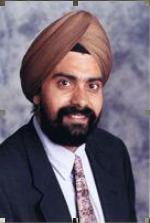Mr Ajit Singh
Mr. Ajit Singh: CEO Siemens
- article with thanks to sikhreview.org by Paul Imbesi Malvern, Pa
Ajit Singh has learned numerous business lessons over the years, but if there is one lesson that sticks out from the others, it is his view on management.
"Build a strong team, hire the best, and then put up with them," said the 44-year-old Mr. Singh, chief executive officer of Siemens Medical Solutions Image and Knowledge Management Group.
Mr. Singh said when smart people are brought into a manager’s team, they will challenge the status quo and the manager, which is good because with true discussion and controversy comes new insight.
"I think artificial harmony is actually too mediocre. It promotes mediocrity. But healthy conflict in which people feel comfortable debating issues, that builds a high-performance culture," he said.
Mr. Singh’s image and knowledge management division was created in September 2006. The division combined four businesses: the radiology information systems and picture archiving and communications systems, cardiology imaging, computer-aided diagnosis and medical knowledge management. He said all four businesses were in different stages of maturity, with medical knowledge management in an incubator stage could turn into a multi-billion dollar business. However, Singh said all of these businesses have a common technology platform and the same fundamental software platform.
Mr. Singh’s group has developed a product that was recently brought to the market called Soarian Quality Measures, a health care data-mining tool that helps hospitals validate their quality measures. Siemens began developing the product over a year ago.
Mr. Singh, who was born in Aligarh, India, and first came to the United States in 1985, has been with Siemens since 1989. He has a doctorate from Columbia University in computer science, and he also has a master’s degree in computer engineering from Syracuse University and a bachelor’s degree in electrical engineering from Banaras Hindu University in India.
According to Mr. Singh, he became involved with Siemens by accident. In 1989, he was giving his doctorate thesis defense at Columbia Univeristy in New York to an open forum, which included invited guests from companies like Bell Labs, IBM, and Siemens.
After his thesis defense, someone from Siemens told Singh that the numbers he was using in his thesis should be applicable to medical imaging. Two weeks later, Singh was speaking at Siemens, and two weeks after that, he was a Siemens employee. Although it happened quickly, Singh said the match was almost serendipitous.
At Siemens, Mr. Singh began in research and development, where he worked on applications in robotics, artificial intelligence and medical imaging from 1989 to 1996. Then he moved to the medical side at the company, where he ran a consulting division from 1996 to 1998. Then from 2000 to 2006, Mr. Singh ran the oncology division. He said the four jobs were diverse in their nature and business philosophy, and he looks back and says it was a blast. Singh said it was the combination of several factors that made Siemens so good. One factor is the person who hired him around 1996, Erich Reinhardt, who is currenly the CEO and president of Siemens Medical Solutions and a member of the managing board of Siemens AG.
Another reason why he enjoys Siemens is the company’s culture, which he said is driven by innovation. This is exciting for Singh, because he is a technology-focused person, who is working at a company where three quarters of the products in Siemens’ portfolio are less than three years old in an industry where products typically last 10 years, he said.
Mr. Singh also professes a fascination with the health-care business. He said there is pressure on health-care costs, health-care quality, and other areas where a difference can be made. For example, he pointed out that in 2006, there were 96,000 deaths that took place in hospitals due to preventable medical errors. "If you do the math, it translates to one jumbo jet crashing every other day," he said.
As a generalization, Mr. Singh said medicine is about two things: doing the right thing and doing it efficiently. Singh and his group focus on inefficiencies in hospitals and medical centres, like the lack of automation and the dependence on paper. He said medical offices are rife with inefficiencies, so most of his business focuses on fixing this problem.
Mr. Singh currently leads a group of 2,000 people, which is the largest amount of people he’s had working under him during his career at Siemens. In his previous job in the oncology division, he was in charge of 1,000 people.
He believes a leader brings the right team together, makes them feel empowered, coaches them without becoming too invasive, and gives employees the sense that they are in charge. At the same time, he said a leader must be ready to coach and correct.
He added that adaptability is the key for leaders, which he could not stress enough. With environmental factors and the market changing, for example, he said a manager has to be constantly adapting. He added that making mistakes will happen, and people will fail, but workers need to recover, clean up, and move on.
External links
- youtube.com Video of interview with Mr Ajit Singh
- sikhchic.com

